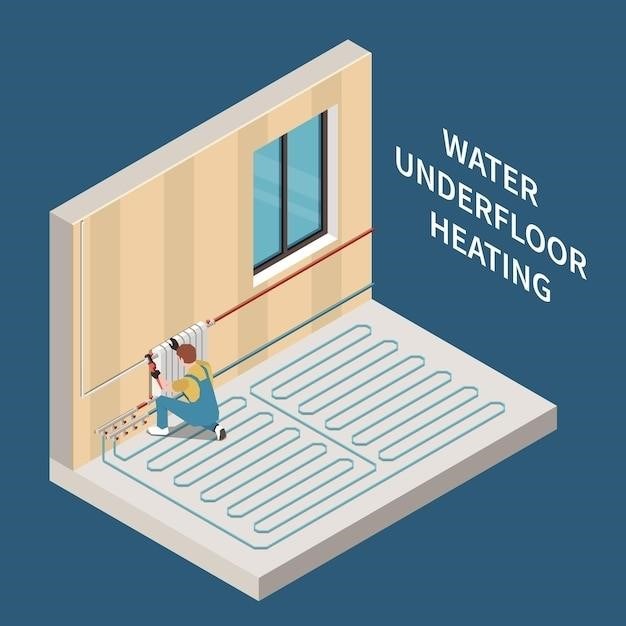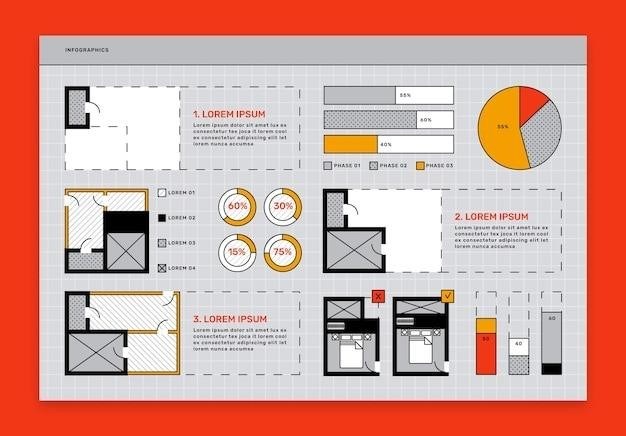This comprehensive guide explores radiant floor heating system design‚ encompassing crucial steps from initial system conception to final installation. We cover various aspects‚ ensuring you understand the process and considerations for successful implementation. Learn about system types‚ component selection‚ and energy efficiency for optimal comfort.
System Design Considerations
Careful planning is paramount for a successful radiant floor heating system. Begin by defining the heated zones within your home‚ considering factors like room usage and heat loss variations. Accurate heat loss calculations are essential to determine the required BTU output for each zone‚ ensuring adequate heating capacity. This involves assessing insulation levels‚ window efficiency‚ and climate conditions. The chosen heat source (electric or hydronic) significantly influences the design‚ impacting installation complexity and energy efficiency. For hydronic systems‚ the boiler size‚ piping layout‚ and manifold configuration must be meticulously planned to optimize water flow and heat distribution. Consider the type of flooring material‚ as its thermal properties affect heat transfer and the overall system efficiency. Finally‚ factor in the budget constraints for materials‚ labor‚ and equipment to ensure a cost-effective design.

Choosing a Heat Source⁚ Electric vs. Hydronic
The selection of a heat source—electric or hydronic—is a critical design decision. Electric radiant heating systems‚ often using heating cables or mats‚ are simpler to install‚ particularly in smaller areas or renovations. They offer zonal control‚ allowing for independent temperature regulation in different rooms. However‚ electric systems are generally more expensive to operate due to higher electricity costs. Hydronic systems‚ utilizing a boiler to heat water circulated through tubing embedded in the floor‚ provide a more even and efficient heat distribution across larger spaces. They are typically more cost-effective in the long run‚ especially when integrated with renewable energy sources. Hydronic systems require more extensive installation‚ involving the boiler‚ piping‚ and manifolds. The choice hinges on factors like budget‚ space requirements‚ existing infrastructure‚ and long-term operating costs. Consider the climate‚ energy prices‚ and overall home heating needs for informed decision-making.
Hydronic System Components⁚ Boiler‚ Tubing‚ Manifolds
A hydronic radiant floor heating system relies on several key components working in harmony. The boiler acts as the heart of the system‚ heating water to a specific temperature. Choosing a high-efficiency boiler is crucial for optimal energy performance and long-term cost savings. The selection of tubing material is also vital; PEX (cross-linked polyethylene) tubing has gained popularity due to its flexibility‚ resistance to leaks‚ and ease of installation. However‚ ensure the PEX tubing includes an oxygen barrier to prevent corrosion of metal components within the system. Manifolds serve as central distribution points‚ regulating water flow to individual heating zones or loops. They enable precise control over heat distribution throughout the floor‚ allowing for customized temperature settings in different areas of the house. Careful consideration of boiler capacity‚ tubing length‚ and manifold design is crucial for balanced and efficient heat distribution. Proper sizing of components ensures the system operates optimally and meets the heating demands of the space.
Tubing Installation Methods⁚ Concrete Slab‚ Existing Slab‚ Subflooring
The method of installing the tubing depends significantly on the existing floor construction. For new concrete slab installations‚ the tubing is embedded within the wet concrete pour‚ requiring careful planning and execution to ensure even heat distribution and prevent damage to the tubing during the pouring process. Existing concrete slabs present a different challenge. In such cases‚ the tubing is typically installed over the existing slab‚ often using a thin layer of self-leveling cement to secure the tubing and create a smooth surface for the final floor covering. This approach requires careful consideration of floor height increases. Subflooring installation offers another option‚ particularly for renovations. The tubing is stapled or affixed to the subflooring‚ often utilizing pre-engineered panels with integrated channels for simpler and faster installation. Each method requires specific expertise and considerations regarding insulation‚ floor height‚ and compatibility with the chosen flooring material. Selecting the appropriate installation method is crucial for ensuring the system’s efficiency and longevity.
Insulation and Heat Loss Calculations
Accurate heat loss calculations are fundamental to designing an efficient radiant floor heating system. These calculations determine the required heat output to maintain a comfortable indoor temperature‚ considering factors such as climate‚ building insulation levels‚ and desired room temperature. Proper insulation minimizes heat loss to the ground or surrounding structures‚ maximizing efficiency and reducing energy consumption. Insulation materials‚ such as rigid foam boards‚ are strategically placed beneath the tubing to prevent downward heat loss. The R-value of the insulation‚ representing its thermal resistance‚ plays a crucial role in the calculations. Higher R-values indicate better insulation and lower heat loss. Software and online tools can assist in performing these calculations‚ considering various parameters and providing detailed recommendations for optimal insulation placement and thickness; Accurate heat loss calculations are crucial for determining the appropriate tubing layout‚ spacing‚ and the boiler’s capacity in hydronic systems‚ thus ensuring an effective and cost-effective radiant heating system.
Floor Construction and Material Selection
The choice of floor construction significantly impacts radiant heating system performance and installation. Common methods include concrete slabs‚ existing slabs with overlay systems‚ or subflooring installations. Concrete slabs offer excellent thermal mass‚ storing and releasing heat evenly‚ creating a stable and comfortable environment. Existing slabs may require specific underlayments to accommodate the tubing and ensure effective heat transfer. Subflooring installations‚ often using panels with integrated channels‚ offer a faster and potentially less disruptive installation method‚ especially in renovations. Material selection for the finished floor is crucial; some materials conduct heat more effectively than others. Tile and stone are excellent conductors‚ providing quick and even heat distribution. Engineered hardwood can also be used‚ but solid hardwood might be prone to warping or cupping with radiant heat. Carpet and vinyl flooring have lower thermal conductivity‚ impacting heat transfer efficiency. Understanding the thermal properties of different materials is crucial for optimizing the system’s performance and ensuring a harmonious blend of comfort‚ aesthetics‚ and energy efficiency in your radiant floor heating design.
Design Software and Tools
Designing a radiant floor heating system efficiently requires specialized software and tools. These aids simplify the complex calculations involved in heat loss estimations‚ tubing layout optimization‚ and overall system sizing. Many software packages provide intuitive interfaces‚ allowing users to input room dimensions‚ insulation values‚ and desired temperatures. The software then calculates the required tubing length‚ loop configurations‚ and manifold sizing‚ ensuring optimal heat distribution throughout the space. These tools often include features for generating detailed schematics and material lists‚ streamlining the installation process. In addition to software‚ various online calculators and design tools are available‚ offering simplified estimations for smaller projects or initial planning stages. Using these resources can help avoid costly mistakes and ensure that the system is appropriately sized and configured for optimal energy efficiency and comfortable heating. Careful selection and utilization of design software and tools are crucial for a successful radiant floor heating project.

Energy Efficiency and Cost Savings
Radiant floor heating offers significant energy efficiency advantages compared to traditional heating systems. Its ability to heat surfaces directly creates a more even temperature distribution‚ reducing the need for higher air temperatures to achieve the same level of comfort. This results in lower energy consumption and reduced fuel bills. The system’s inherent thermal mass also helps maintain consistent temperatures‚ reducing the frequency of heating cycles and further lowering energy usage. Hydronic systems‚ in particular‚ benefit from the ability to operate at lower water temperatures‚ increasing boiler efficiency and extending its lifespan. Careful system design‚ including proper insulation and heat loss calculations‚ is crucial for maximizing energy savings. The use of high-efficiency boilers and programmable thermostats also contributes to reduced energy consumption. While initial installation costs may be higher‚ the long-term energy savings often outweigh the upfront investment‚ making radiant floor heating a cost-effective choice for homeowners seeking both comfort and affordability.
Integration with Renewable Energy Sources
Radiant floor heating systems‚ especially hydronic ones‚ are highly compatible with various renewable energy sources‚ significantly enhancing their environmental friendliness and long-term cost-effectiveness. Solar water heaters are an excellent match‚ efficiently supplying the lower-temperature water required for radiant floor heating. Geothermal heat pumps‚ another sustainable option‚ provide a consistent and reliable heat source‚ minimizing reliance on fossil fuels. The integration of these renewable sources reduces the system’s carbon footprint‚ aligning with environmentally conscious building practices. Design considerations for integrating renewable energy involve sizing the heat source appropriately to meet the heating demand‚ ensuring efficient energy transfer between the renewable source and the radiant floor system. Proper system balancing is crucial to optimize the performance and efficiency of both the renewable energy system and the radiant floor heating. This integrated approach offers both environmental benefits and potential cost reductions on energy bills over the system’s lifespan‚ making it an increasingly attractive option for eco-conscious homeowners.
Installation Considerations for Retrofits
Retrofitting radiant floor heating into existing homes presents unique challenges and considerations compared to new construction. Accessibility to the subfloor is paramount; basement or crawl space access simplifies installation by allowing tubing placement beneath the subfloor for optimal efficiency. If access is limited‚ more invasive methods might be necessary‚ potentially requiring the removal of existing flooring and potentially even portions of ceilings below to access the subfloor; The type of existing flooring significantly influences the installation process and material choices. Careful planning is crucial to minimize disruption and ensure compatibility with the existing structure. Professional assessment is advisable to determine feasibility‚ potential challenges‚ and the most suitable installation method. Material selection‚ considering both efficiency and compatibility with existing materials‚ is key. Pre-fabricated panels with integrated tubing channels can simplify installation and improve efficiency‚ especially in retrofit situations. A thorough understanding of these factors is crucial for a successful and cost-effective radiant floor heating retrofit.
Troubleshooting and Maintenance
Regular maintenance is crucial for ensuring the longevity and efficiency of your radiant floor heating system. Periodically inspect tubing for leaks‚ paying close attention to connections and areas prone to stress. Addressing minor issues promptly prevents larger‚ more costly problems down the line. Regularly check and clean the boiler or heat pump‚ following manufacturer guidelines for maintenance schedules and procedures. Air bleeding from the system is essential to maintain optimal performance and prevent inefficient operation caused by trapped air. Inspect the thermostat and control systems‚ ensuring accurate temperature readings and proper functionality. Addressing any malfunctions promptly is key to avoiding significant disruptions to heating. Properly maintaining the system’s insulation helps in reducing energy waste and maximizing efficiency. Understanding the system’s components and their potential failure points allows for quicker identification and resolution of problems. For complex issues‚ consulting a qualified professional ensures prompt and effective solutions‚ preventing further damage or safety hazards.